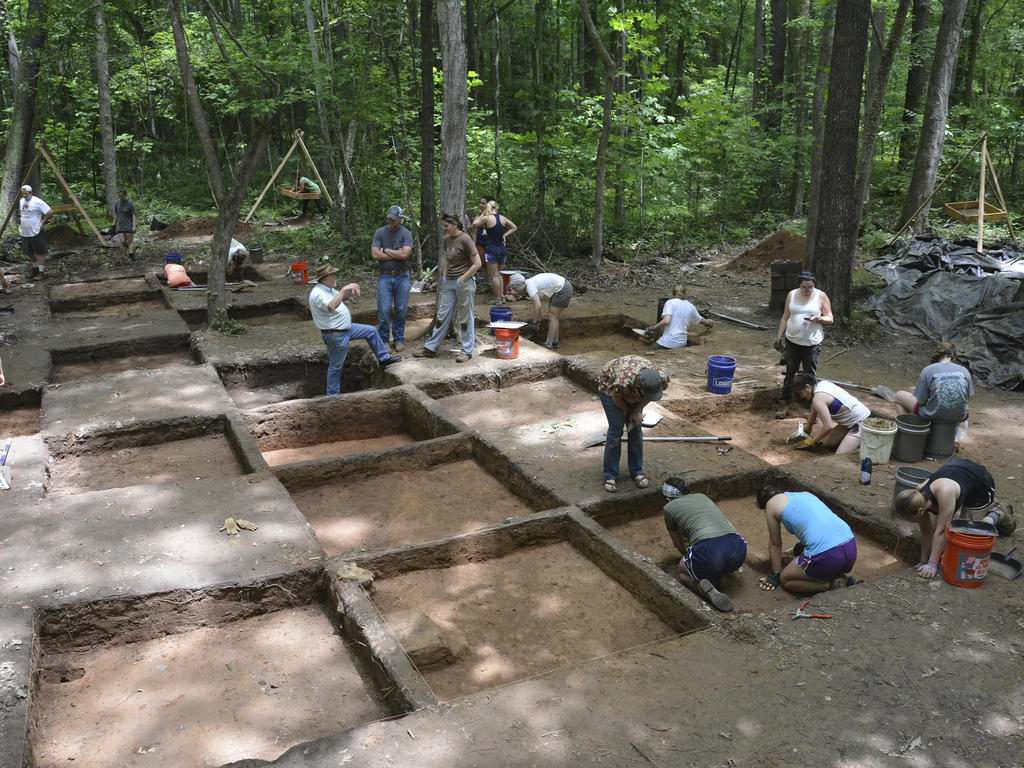By Margaret Tronsor ‘17
With nearly a decade of work behind it, the Ames Plantation Field School archaeology Maymester at Rhodes continues to yield new discoveries. The 3-week program is an exercise in interdisciplinary scholarship and hands-on learning in which students with little to no experience in the field are given the tools and opportunity to excavate a working archaeological site.
“There’s a heavy experiential component to the field school. It’s environmental archaeology with a spin of ethnoarchaeology,” explains Professor Kimberly Kasper, the lead faculty member on the project. In essence, the field school has a science-lab based curriculum that includes fieldwork, lectures, and visits to nearby archaeological sites. Jamie Evans (from Ames Plantation) and Ellie Maclin (from Oak Hill Heritage Farm) also help coordinate and run the field excavation. Additional Rhodes supporting faculty include Dean Milton Moreland, who started the program in 2006.
Located about an hour east of Memphis, the Ames Plantation is the 18,600-acre site of both a 19th-century manor house and plantation and Native American mounds dating back thousands of years. The Maymester students have been excavating the slave cabins and manor house of Fanny Dickins, who challenged antebellum gender roles by owning and running her own plantation.
This summer, the team discovered a second house on the property, an exciting and important find. “Of course, on the second to last day, we found what is the beginning of a really rich organic layer . . . it could be a root cellar or the floor of a house,” says Kasper. “It’s like nothing we’ve seen on this site before.”
This year’s dig also yielded many daily items such as beads, pipe fragments, and buttons. By digging up seemingly ordinary items, students can figure out how people of the time actually lived, as opposed to the accounts provided by primary documents and secondary sources (such as what can be found in your history books). The students draw their own conclusions from what they find, gaining a better understanding of what it meant to be human—whether slave or slave owner—in antebellum Tennessee.
The artifacts on the property are not all from the 19th century. Elliot Hope ’18 most enjoyed finding a tool that lies outside the time frame of antebellum Tennessee. “The most exciting thing we found on the dig was probably a piece of worked stone (chert) that Dean Moreland suggested might have been part of a Native American weapon and predated the slave cabins we were studying.” How did that artifact come to rest at the slave quarters of Fanny Dickins? It is possible that the Native American tool may have been found by Dickin’s slaves who worked her fields, and then kept as a “keepsake” in the slave household.
In addition to digging for artifacts and attending lectures, students live a little of the history themselves. For example, students build their own fires and even make their own pots using the clay from the river bed. “They’re getting involved in some activities that Native Americans, settler populations, and even slave populations would have engaged in,” says Kasper.
Students also study environmental factors, including analyzing pollen samples and seeds and using tree ring data to date sites. In this way, says Kasper, students are able to make connections to the present day. “Ames Plantation is a great case study for today regarding food and commodity production and emerging social interactions. Examining that production in the 19th century could lead to more sustainable techniques for the future,” she explains. “Within today’s agricultural systems, farmers can only reach about 80% of what cotton yields were in the 1840s, even with the use of chemicals and fertilizers.”
Findings from years past have been presented at the Ames Plantation annual Heritage Festival and been the subject of a course at the Meeman Center for Lifelong Learning. Beyond academic motivations, however, the Ames Plantation Field School is simply an enjoyable adventure in rural Tennessee. “There’s something for everyone when it comes to understanding this particular landscape,” says Kasper, adding that this year’s group of students was mostly women. “We had 19 females and 2 males, but they moved the most amount of dirt we have ever excavated!”
Photos courtesy of Ames Plantation Maymester Field School; to see more pictures from the dig, visit the field school′s photo gallery.
